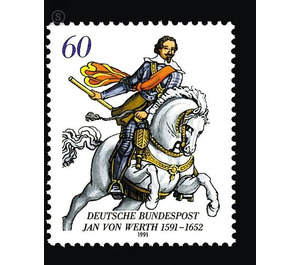400th birthday of Jan von Werth - Germany / Federal Republic of Germany 1991 - 60 Pfennig
Theme: Animals
| Country | Germany / Federal Republic of Germany |
| Issue Date | 1991 |
| Face Value | 60.00 |
| Color | multi-colored white |
| Perforation | K 13 3/4: 14 |
| Printing Type | Six-color offset printing |
| Stamp Type | Postage stamp |
| Item Type | Stamp |
| Chronological Issue Number | 1377 |
| Chronological Chapter | GER-BRD |
| SID | 789594 |
| In 54 Wishlists | |
Jan von Werth was one of the best-known and most-portrayed military leaders of his time. His popularity stems from his descent from humble background, his courageous bravado, the solicitous care he claimed for his soldiers and a gentle treatment of the war-tormented rural population that was not common at the time. He was born in 1591 as the son of a farmer's family in the parish Büttgen belonging to the Archdiocese of Cologne. The place Büttgen is today part of the city Kaarst in the district of Neuss. An exact date of birth can not be determined because the church books were lost due to the war events of that time. An oil painting from 1650 shows him as a 59 year old. Around the year 1610 he joined the Spanish army under General Spinola; In 1631 he moved to Kurkölnische, 1632 in Bavarian services. His valor, shown in various battles, allowed him to rise in rapid succession to the Captain (1622), Obristwachtmeister (1631), Obrist (1632), General Wachtmeister and Field Marshal Lieutenant (1634) and General of the Cavalry (1643). Emperor Ferdinand II raises Werth on April 4, 1635 in the Imperial Free Reach. On March 3, 1638 he gets caught in Rheinfelden in captivity and spends four years in Paris as a highly respected and secretly admired prisoner until 1642 he is exchanged for the Swedish Field Marshal Horn. Elector Maximilian I of Bavaria concludes an armistice with Sweden and France in March 1647. As a Bavarian and imperial general, Werth falls into a conflict of conscience and decides on the emperor, who does not approve of the truce. Werth is therefore ostracized by Maximilian I. from the emperor he receives the rule Benatek in Bohemia. There he died on 12 September 1652. Werth was married three times. He had two children with his first wife, Gertrud von Ghent, to Loenen. The daughter Lambertine Irmgardis from this marriage married 1647 Winand Hieronymus Raitz von Frentz to Schlenderhan. From this marriage the only descendants and heirs that can be traced to the present day come from. The second marriage was in 1637 with Maria Isabelle Countess Spaur in Straßberg. A son from this marriage seems to have died as a child. The third marriage closed Werth 1648 with Susanna Maria Countess Kuefstein. A son from this marriage died early and left no offspring. In his will Werth has left his legacy Büttgen various legates, such as for soul fairs for himself and for his family, for the poor of the place and the seminar in Dusseldorf for two students from Büttgen needy students. A petite epitaph created on his request shows the praying Werth in a kneeling position and can still be seen in front of the church in Büttgen. After all, he decided to set up a foundation to meet the needs of those days: "to bake a Malt Wheat and, according to the memory of the year, to distribute it to the children and worshipers who desire it". These Werth awakenings will be distributed according to his wishes, even today on the day of his annual memory in the church of Büttgen after the Mass. Jan von Werth also acquired land in Cologne, the "Raitzenhaus" or "Haus Merheym" on Gereonstrasse. The people of Cologne have him in their hearts closed. The poem by Jan and Griet, written around 1836, the young man who was rejected at first, and who later saw the girl as a famous hero, has contributed greatly to the popularity of Werth ("Why, who could have!" - "Jan, whoever had jewußt! "). The people of Cologne included Werth in their carnival, and the Reitercorps Jan von Werth e.V. Köln, an active carnival club, recreates the scene with Jan and Griet at the Severinstor every year on a parade on the day of the Altweiberfastnacht. (Text: Max Mauritz, head of the working group Jan von Werth, St. Sebastianus-Schützenbrüderschaft, Kaarst)


